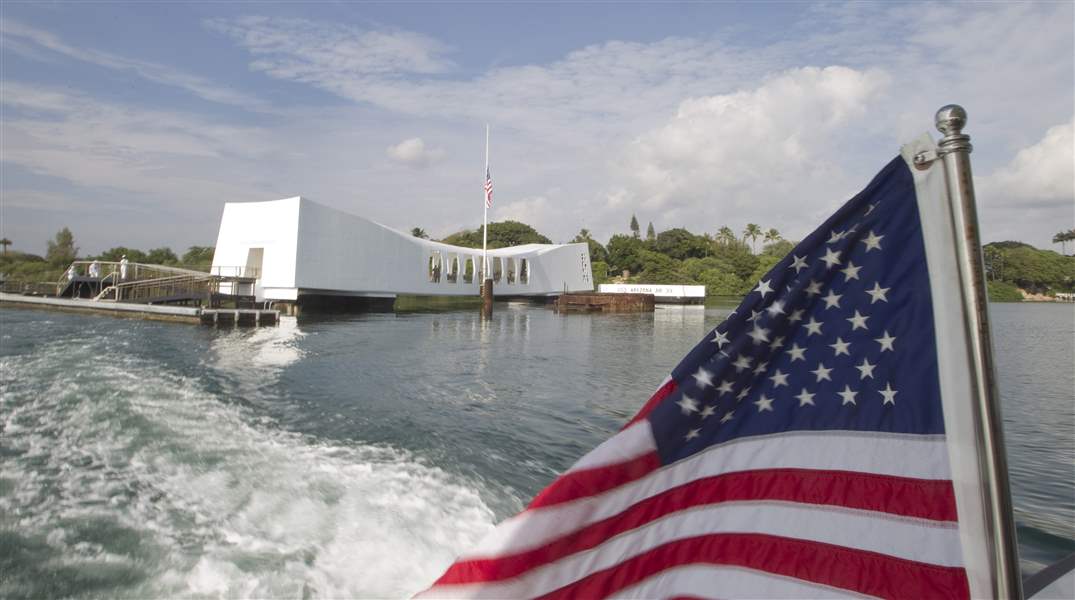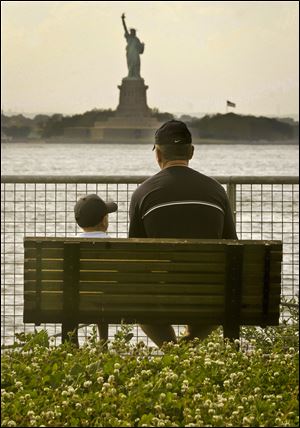
Ariz., some other states agree to U.S. government offer on reopening shuttered national parks
10/12/2013
FILE - This Dec. 7, 2012 file photo shows The USS Arizona Memorial at Pearl Harbor, Hawaii. Hawaii is unlikely to reopen national parks in the islands during the federal government shutdown because it appears the state wouldn't be reimbursed for doing so. Gov. Neil Abercrombie spokeswoman Louise Kim McCoy said Friday Oct. 11, 2013, reimbursement isn't the only factor the state needs to consider but it's a huge one. (AP Photo/Eugene Tanner, File)
ASSOCIATED PRESS

As the federal shutdown continues, state and federal officials were discussing the possible reopening of the Statue of Liberty, while Arizona officials weighed whether to pay the federal government to reopen Grand Canyon National Park.
FLAGSTAFF, Ariz. — Tourists returned to the Grand Canyon today after Arizona officials along with several counterparts agreed to a federal government plan to reopen national parks, which had been closed as a result of the partial government shutdown.
But the Obama administration’s OK to reopen tourist areas across the nation came with a big caveat: States must foot the bill with money they likely won’t see again.
So far, Utah, Colorado, South Dakota, Arizona and New York have agreed to open parks that had been closed since the beginning of the month. Meanwhile, governors in other states were trying to gauge what would be the bigger economic hit — paying to keep the areas operating or losing the tourist money that flows when the scenic attractions are open.
South Dakota and several corporate donors worked out a deal with the National Park Service to reopen Mount Rushmore beginning Monday. Republican Gov. Dennis Daugaard said it will cost $15,200 a day to pay the federal government to run the landmark in the Black Hills. He said he has wired four days’ worth of donations.
In New York, Democratic Gov. Andrew Cuomo said his state will pay $61,600 a day to fully fund Park Service personnel and the Statue of Liberty will open Sunday.
In Arizona, Republican Gov. Jan Brewer balked at spending about $112,000 a day for a full reopening of the Grand Canyon. She said a partial reopening would be much cheaper while allowing tourists to visit and businesses to benefit.
“The daily cost difference is enormous, especially without assurances that Arizona will be reimbursed,” said Andrew Wilder, a spokesman for Brewer.
In the end, Arizona agreed to pay the Park Service $651,000 to keep the Grand Canyon open for seven days. The $93,000 a day is less than the $112,000 the federal government had said was needed to fund park operations each day.
In additional to state money, cash provided by the town of Tusayan, just outside the South Rim entrance, and private business would also be included in the funding.
At this time of year, the Grand Canyon draws about 18,000 people a day who pump an estimated $1 million a day into the local economy.
The town of Tusayan, and area businesses have pledged $400,000 to help reopen the canyon, but Wilder said it was unclear if the Interior Department could accept private funds.
In Utah, federal workers rushed to reopen five national parks for 10 days after the state sent $1.67 million to the U.S. government with the hope of saving its lucrative tourist season.
Zion National Park superintendent Jock Whitworth said staff members began opening gates and removing barriers and expected to have the park fully operational today.
“This is a practical and temporary solution that will lessen the pain for some businesses and communities in Utah during this shutdown,” Interior Department Secretary Sally Jewell said in a statement.
It was welcome news for beleaguered shop owners in the small town of Springdale adjacent to Zion. Hotels have been vacant and rental and retail shops have seen sales plummet during the shutdown.
“It’s going to be awesome,” said Jenna Milligan of Zion Outfitters, an outdoor gear rental shop. “A lot of businesses have suffered severely because of the government. I just hope it does stay open through autumn.”
In Colorado, officials said a deal had been struck for the state to pay $360,000 to reopen Rocky Mountain National Park for 10 days to allow tourists to reach Estes Park. The visitors are needed to help the town recover from flooding.
Slightly more than 400 national parks, recreation areas and monuments — including such icons as the Grand Canyon and Yosemite — have been closed since Oct. 1 because of the partial government shutdown.
More than 20,000 National Park Service employees have been furloughed, and lawmakers from both parties have complained that the closures have wreaked havoc on communities that depend on tourism.
Interior Department spokesman Blake Androff said Thursday the government had no plans to reimburse states that pay to reopen parks. But members of Congress introduced legislation Friday to refund the money within 90 days.
In Utah, Republican Gov. Gary Herbert estimated the economic impact of the federal government shutdown at $100 million in his state.
Missouri Democrat Gov. Jay Nixon’s administration was working on a proposal to reopen parks in that state, including the Gateway Arch grounds in St. Louis and the Ozark National Scenic Riverways Park in southern Missouri.
Washington state Gov. Jay Inslee, a Democrat, said his state can’t afford to reopen its parks, as did Nevada Republican Gov. Brian Sandoval.
Sandoval said Nevada is already facing critical funding decisions on dozens of programs, including food stamps, unemployment insurance and aid to women, infants and children.
In Wyoming, Republican Gov. Matt Mead’s office said the state would not pay to reopen two heavily visited national parks or Devil’s Tower national monument.
“Wyoming cannot bail out the federal government, and we cannot use state money to do the work of the federal government,” Mead spokesman Renny MacKay said.